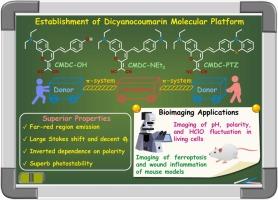Harnessing a multifunctional far-red fluorescence platform for high-performance biological sensing and imaging
IF 8
1区 化学
Q1 CHEMISTRY, ANALYTICAL
引用次数: 0
Abstract
Fluorescence imaging has provided abundant information in biological researches, which unveils the microscopic nexuses in physiological and pathological processes. Nevertheless, this main-stream solution is always impeded by intractable drawbacks of imaging tools including small Stokes shift, short-wavelength emission, inferior photostability, and insufficient fluorescence quantum yield (ΦF). In this contribution, an ingenious molecular platform constituted of three novel dicyanocoumarin analogues is rationally engineered. With large Stokes shift, its fluorescence is located in the far-red region. Serendipitously, an unexpected phenomenon is uncovered that emission of these novel compounds enhances along with the increase of polarity, which confers them considerable ΦF. Due to such merits, this multifunctional fluorescence platform is applied to cellular imaging due to its multivariate spectral responsiveness toward pH, polarity, and hypochlorous acid (HClO). Besides, in vivo imaging of ferroptosis and wound inflammation mouse models has also revealed the great potential of this fluorescence platform. Performing eminent bioimaging results, we conceive that this fluorescence platform would be a robust imaging toolbox in the future, which provides designing inspiration for development of high-performance fluorophores.

求助全文
约1分钟内获得全文
求助全文
来源期刊

Sensors and Actuators B: Chemical
工程技术-电化学
CiteScore
14.60
自引率
11.90%
发文量
1776
审稿时长
3.2 months
期刊介绍:
Sensors & Actuators, B: Chemical is an international journal focused on the research and development of chemical transducers. It covers chemical sensors and biosensors, chemical actuators, and analytical microsystems. The journal is interdisciplinary, aiming to publish original works showcasing substantial advancements beyond the current state of the art in these fields, with practical applicability to solving meaningful analytical problems. Review articles are accepted by invitation from an Editor of the journal.
 求助内容:
求助内容: 应助结果提醒方式:
应助结果提醒方式:


